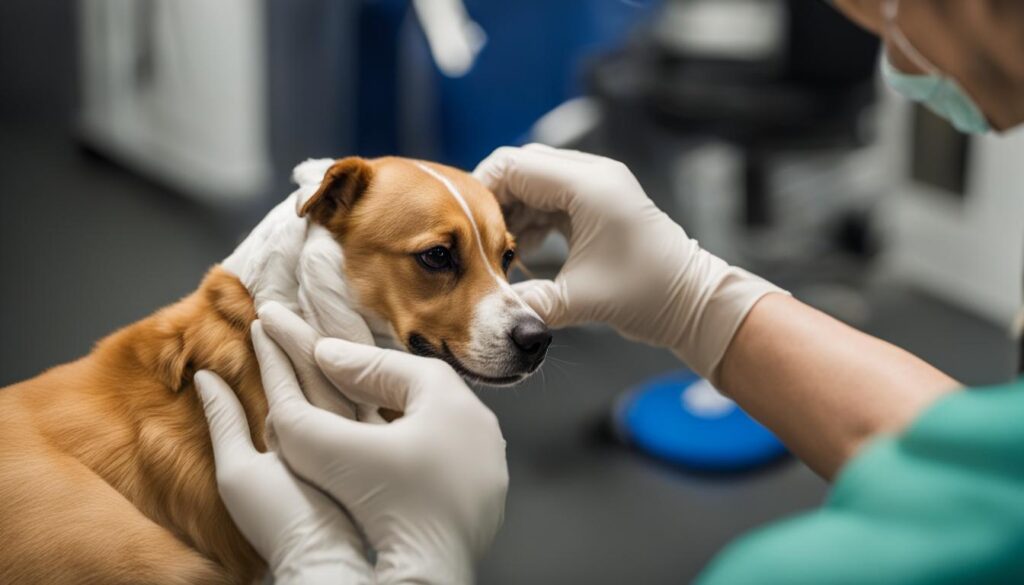Luxating patella in dogs is a common orthopedic condition that can cause mobility issues and pain. It occurs when the kneecap slips out of its normal position in the knee joint. This condition can affect one or both knees and is more common in certain breeds, such as toy and small breeds. Factors that contribute to luxating patella include abnormal bone conformation, ligament or joint capsule abnormalities, and tight quadriceps muscles or loose patellar tendon. Diagnosis is typically done through a physical examination, and treatment options range from conservative management to surgical correction.
Key Takeaways:
- Luxating patella is a condition where the kneecap slips out of its normal position in dogs.
- Factors that contribute to luxating patella include abnormal bone conformation and muscle imbalances.
- Diagnosis is typically done through a physical examination by a veterinarian.
- Treatment options range from conservative management to surgical correction, depending on the severity of the condition.
- Regular veterinary check-ups and monitoring are essential for long-term management of luxating patella in dogs.
What is a Luxating Patella in Dogs?
A luxating patella in dogs refers to the dislocation of the kneecap from its normal position in the knee joint. The patella can slide medially or laterally, affecting one or both knees. This condition limits a dog’s ability to fully extend the hind limb and can lead to holding the leg up while the knee is flexed. Luxating patella is one of the most common orthopedic conditions seen in veterinary medicine.
Understanding the normal anatomy of a dog’s knee joint is important to grasp how luxating patella affects a dog’s mobility. The knee joint includes the femur (thigh bone), tibia (shin bone), and patella (kneecap). The patella is normally seated in a groove on the femur called the trochlear groove. In dogs with a luxating patella, this groove may be shallow or misshapen, causing the patella to dislocate or slip out of place.
The severity of a luxating patella is typically graded on a scale from 1 to 4, with grade 1 being the mildest and grade 4 being the most severe. Dogs with a grade 1 luxating patella may only experience occasional lameness, while dogs with a grade 4 luxating patella may have a permanently dislocated kneecap. It’s important to consult with a veterinarian if you suspect your dog may have a luxating patella, as early diagnosis and treatment can help prevent long-term complications.
The Impact on a Dog’s Mobility
A luxating patella can significantly affect a dog’s mobility and overall quality of life. When the kneecap dislocates, it can cause pain, lameness, and a change in gait. Dogs may have difficulty fully extending their hind legs or may hold the affected leg up while walking. This can lead to a hopping or skipping motion and can make it challenging for dogs to engage in activities they once enjoyed. If left untreated, a luxating patella can lead to the development of arthritis and other secondary orthopedic conditions.
Causes and Risk Factors of Luxating Patella in Dogs
A luxating patella in dogs can have several causes and risk factors that contribute to its development. One of the main factors is genetics, as certain breeds are more prone to this condition. Breeds such as Chihuahuas, Pomeranians, and Yorkshire Terriers are commonly affected. Additionally, abnormalities in bone conformation, such as a shallow trochlear groove, can increase the risk of patellar luxation. Ligament or joint capsule abnormalities and tight quadriceps muscles or loose patellar tendon can also contribute to the condition.
Developmental abnormalities and traumatic injuries are other possible causes of luxating patella in dogs. Dogs with poor nutrition during their growth stages may also be at a higher risk. Furthermore, obesity is considered a risk factor for developing luxating patella. The excess weight puts additional stress on the joints, increasing the likelihood of patellar luxation.
It is important to note that while these factors may increase the likelihood of luxating patella, it does not guarantee that a dog will develop the condition. The interplay of genetic predisposition, conformation, and environmental factors contribute to the development of patellar luxation.
Signs and Symptoms of Luxating Patella in Dogs
The signs and symptoms of luxating patella in dogs can vary, but understanding these indicators can help pet owners identify and address the condition. Dogs with a luxating patella may exhibit intermittent skipping or limping, where they suddenly lift one hind leg while walking or running. This behavior is often accompanied by a change in gait and can be a clear sign of discomfort. Additionally, dogs with a luxating patella may experience stiffness or difficulty rising, especially after periods of rest.
Other symptoms to look out for include pain and discomfort, which may be evident through the dog’s reluctance to bear weight on the affected leg or a noticeable decrease in activity. Swelling around the affected knee joint is also a possible symptom. It is important not to ignore these signs, as untreated luxating patella can lead to the development of secondary arthritis and further mobility issues. Seeking veterinary attention is crucial if any of these symptoms are observed in a dog.
Recognizing the signs
Recognizing the signs of luxating patella is essential for early detection and intervention. By paying close attention to changes in your dog’s behavior, gait, and mobility, you can identify potential issues and seek appropriate veterinary care. Prompt diagnosis and treatment can lead to better outcomes and improved quality of life for your furry friend.
Diagnosing Luxating Patella in Dogs
When it comes to diagnosing luxating patella in dogs, a thorough examination by a veterinarian is crucial. During the physical examination, the vet will assess the stability and movability of the kneecap to determine the severity of the condition. This may involve manipulating the leg, feeling for any abnormalities or clicking sensations, and observing the dog’s gait and range of motion. The veterinarian will assign a grade to indicate the severity of the luxation, which can range from grade I (mild) to grade IV (severe).
In some cases, additional diagnostic tests may be recommended to further evaluate the bones and soft tissues within the joint. This can include X-rays or advanced imaging such as CT scans, which provide a more detailed view of the knee joint. These tests can help determine the extent of any structural abnormalities and assist in planning the most appropriate treatment approach.
Importance of a Comprehensive Examination
A comprehensive examination is essential for accurate diagnosis and treatment planning. It allows the veterinarian to assess the overall health of the dog and ensure that there are no underlying conditions that could affect the treatment options or prognosis. Additionally, a comprehensive examination helps rule out other potential causes of lameness or discomfort, such as musculoskeletal injuries or joint infections.

Overall, diagnosing luxating patella in dogs requires a combination of physical examination and, in some cases, diagnostic imaging. It is important to consult with a veterinarian if you suspect your dog may be suffering from a luxating patella, as early diagnosis and appropriate treatment can help improve your furry friend’s quality of life.
Treatment Options for Luxating Patella in Dogs
Treating luxating patella in dogs involves various options depending on the grade and severity of the condition. Mild cases may not require immediate treatment and can be managed through conservative measures. This includes maintaining a healthy weight for the dog to reduce strain on the joints. Regular exercise is important, but low-impact activities are recommended to avoid putting excessive pressure on the affected knee joint.
In cases where the luxating patella causes frequent or persistent lameness, surgical correction may be necessary. There are different surgical procedures available, such as repositioning the patella and reattaching the patellar ligament or reshaping the femoral groove. The choice of surgery will depend on the individual dog’s condition and the orthopedic specialist’s recommendation.
Rehabilitation is an important aspect of treatment for dogs with luxating patella, whether they undergo surgery or not. Physical therapy, including exercises to strengthen the muscles around the knee joint, can aid in recovery and improve the dog’s overall mobility. Your veterinarian or a certified canine rehabilitation therapist can provide guidance on specific exercises and techniques to help your dog regain strength and flexibility.
Alternative Therapies
In addition to traditional treatment options, some pet owners may explore alternative therapies for managing luxating patella in dogs. These can include acupuncture, chiropractic care, and herbal or homeopathic remedies. It is important to consult with a holistic veterinarian before pursuing any alternative therapies, as not all treatments may be suitable or supported by scientific evidence.
Managing Luxating Patella in Dogs
Managing a luxating patella in dogs involves a comprehensive approach that combines treatment options and lifestyle modifications. With proper care and attention, dogs with this condition can lead comfortable and active lives. Here are some key strategies for managing luxating patella in dogs:
Weight Management:
Keeping your dog at an ideal weight is crucial in managing luxating patella. Excess weight can put additional stress on the joints, making the condition worse. Consult with your veterinarian to determine the appropriate diet and exercise plan for your dog to maintain a healthy weight.
Low-Impact Exercise:
Engaging in low-impact exercises can help strengthen the muscles surrounding the knee joint and improve overall joint stability. Activities such as swimming, leash walking, and controlled play sessions are ideal for dogs with luxating patella. Avoid high-impact activities that may exacerbate the condition.
Orthopedic Support:
Providing your dog with orthopedic bedding and ramps can enhance their comfort and mobility. These supportive measures help reduce stress on the joints and provide a comfortable resting place for your pet. Additionally, consider using joint supplements, as advised by your veterinarian, to support joint health.
Physical Therapy and Rehabilitation:
Under the guidance of a veterinary professional, physical therapy and rehabilitation exercises can be beneficial in managing luxating patella. These exercises focus on strengthening the muscles around the knee joint, improving range of motion, and reducing pain and inflammation. Your veterinarian can recommend specific exercises tailored to your dog’s needs.

Remember, managing luxating patella requires ongoing care and close monitoring of your dog’s condition. Regular veterinary check-ups are essential for evaluating the effectiveness of the management plan and making any necessary adjustments. By implementing these strategies and providing your dog with the support they need, you can help them live a happy and active life despite luxating patella.
Prognosis and Outlook for Luxating Patella in Dogs
When it comes to the prognosis and outlook for dogs with a luxating patella, several factors come into play. The severity of the condition and the dog’s response to treatment are key determinants of the long-term prognosis. Dogs without significant clinical signs typically have a good prognosis and can live comfortably for many years with proper management.
For dogs that require surgical correction, the prognosis is generally positive, especially when the surgery is performed before the onset of arthritis. Surgical procedures such as repositioning and reattaching the patellar ligament or reshaping the femoral groove can restore stability and alleviate chronic pain. Regular follow-up visits with a veterinarian are necessary to monitor the dog’s progress and make adjustments to the treatment plan if needed.
However, it’s important to note that large breed dogs with a luxating patella may have a less favorable prognosis due to the increased risk of additional orthopedic conditions. These dogs may require more intensive management and monitoring to ensure their well-being and quality of life.
Outlook for Luxating Patella
The outlook for dogs with a luxating patella depends on early diagnosis and appropriate treatment. By addressing the condition promptly, pet owners can significantly improve their dog’s quality of life and minimize long-term complications. Regular veterinary check-ups, along with lifestyle modifications and proper management techniques, can help dogs with a luxating patella lead happy and active lives.
Conclusion
In conclusion, luxating patella in dogs is a common orthopedic condition that can cause mobility issues and discomfort. Understanding the causes, symptoms, diagnosis, and treatment options is crucial for providing the best care for our furry companions.
Whether through conservative management or surgical correction, our goal is to improve the quality of life for dogs with luxating patella. Regular veterinary check-ups, lifestyle modifications, and proper management techniques can help ensure that they lead happy and active lives.
By staying informed and working closely with our veterinarians, we can provide the necessary support and care for dogs with luxating patella. Together, we can help our beloved pets overcome the challenges of this condition and enjoy a healthy and fulfilling life.
FAQ
What is a luxating patella in dogs?
A luxating patella in dogs refers to the dislocation of the kneecap from its normal position in the knee joint.
What are the causes and risk factors of luxating patella in dogs?
Luxating patella in dogs can be caused by factors such as genetics, abnormal bone conformation, ligament or joint capsule abnormalities, and tight quadriceps muscles or loose patellar tendon. Certain breeds are more prone to this condition.
What are the signs and symptoms of luxating patella in dogs?
Signs of luxating patella in dogs include intermittent skipping or limping, change in gait, stiffness or difficulty rising, pain and discomfort, and swelling around the affected knee joint.
How is luxating patella in dogs diagnosed?
Luxating patella in dogs is typically diagnosed through a physical examination by a veterinarian. X-rays or advanced imaging may be recommended in some cases.
What are the treatment options for luxating patella in dogs?
Treatment options for luxating patella in dogs range from conservative management, such as weight management, joint supplements, and pain medications, to surgical correction.
How can luxating patella in dogs be managed?
Luxating patella in dogs can be managed through lifestyle modifications, including maintaining an ideal weight, low-impact exercise, orthopedic bedding, and physical therapy.
What is the prognosis and outlook for dogs with luxating patella?
The prognosis for dogs with luxating patella depends on the severity of the condition and the individual dog’s response to treatment. Regular veterinary check-ups are important for monitoring the dog’s condition.



